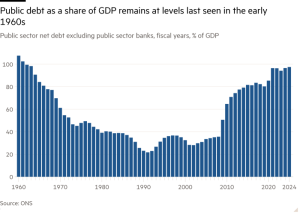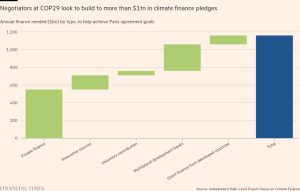Shapewear is coming for men

Stay informed with free updates
Simply sign up to the Fashion myFT Digest — delivered directly to your inbox.
Consumer appetite for products that promise to transform the body is, in today’s climate, seemingly insatiable. Modern girdles designed to cinch the waist to impossibly thin proportions, underwear that gives you a perfectly lifted, peachy butt or, incredibly, bras that offer constant at-attention nipples for the wearer are all part of a growing global underwear market, estimated by Euromonitor International to be worth $125bn in 2023.
While shapewear brands have historically sought to appeal to women — who (especially among a younger generation) seem eager to appear “snatched” — there’s a renewed targeting of men, who pose a relatively untapped area of growth for many brands.
Marguerite Le Rolland, head of footwear and apparel at Euromonitor International, believes that the omnipresence of social media has led millennials and Gen Z to take a heightened interest in their appearance and sharing their personal style online. That includes not just women, but men too, she notes. “Men are increasingly interested in cultivating a more confident and sculpted physique, which creates opportunities for shapewear for men, including men’s sculpting girdle shirts and boxer shorts, that offer compression, comfort and support.”
Making strides in this space is Skims, the shapewear empire founded by Kim Kardashian, which launched a men’s range (consisting of undergarments with various levels of compression) in the US last year and expanded into the UK in May. Sports brands such as Under Armour and Nike sell compression-wear for men to feel “confident no matter where you are on your workout journey”, while Leo, the men’s off-shoot of Colombian underwear company Leonisa, offers shaping tanks, underwear and girdles designed to be worn for exercise or under everyday clothing. There are also a host of direct-to-consumer brands including Mott & Bow, Perk and Jack Archer that market their products — such as “butt-lift jeans” — according to body shapes and sizes, and how to adequately counteract any lumps, bumps or hollows.
Spanx, the original shapewear brand that launched in 2000, expanded into the men’s market in 2010, resulting in mentions on Jimmy Kimmel Live! and in an interview with Steve Carell at the Golden Globes. Merran Mills, a buyer for Selfridges, says Spanx’s collection of compression T-shirts, tanks, boxers and briefs is so discreet and simple that customers might not even realise its sculpting benefits. “Men seeking out shapewear solutions might have a special occasion in mind or want to eliminate bulk under clothes, like a tailored jacket or slim-fit sweater. As an everyday support, shapewear enhances confidence, not only by streamlining, but also by improving posture.”


The history of men in shapewear goes back to the turn of the 18th century, when Beau Brummell and other dandyish figures began wearing forms of corsetry or “stays”, to achieve the military-style bearing that was popular at the time. “Men would wear a girdle or corset to bring the waist in, and then also jackets that tended to be padded around the chest and shoulders, so that you had that broader upper torso and a narrow waist,” says Shaun Cole, associate professor of fashion at the University of Southampton, who adds that calf pads were also worn under breeches. This look was often satirised by the cartoonist George Cruikshank, who was known for his depictions of dandies with nipped-in waists and collars that went all the way up to their noses, who were often overcome with emotion.
In the second half of the 20th century, with the proliferation of elastic material, shapewear took a new form with “Y-front type briefs that had an extended elastic waistband, which would come up and pull in a pot tummy and love handles”, adds Cole. This evolved into a bigger men’s market in the early 2000s, with brands including Andrew Christian, who released underwear with “anti-muffin top elastic” in 2008, and Australian label Equmen, which sold sculpting vests, T-shirts and underwear at Saks Fifth Avenue.
Yet challenges with perception have blocked further mainstream adoption and brands are increasingly promoting compression-wear benefits or sporting prowess when it comes to men’s shapewear. “There is a concerted attempt to try and steer away from anything that seems feminine or is associated with womanly practices,” observes Cole. He points to one of Spanx’s shapewear T-shirts from 2010: “the packaging talks about how compression technology was used to transform the torso and the chest, making the wearer ‘look sharper, stand taller and feel stronger’. There’s a lot of very stereotypical male-associated words here to make this not a feminising garment, but a form of masculine expression.”
Central to the recent success of women’s shapewear is the unashamed wearing of such constricting garments. Skims, for example, promotes wearing its flesh-coloured bodysuits only with jeans, while much of their marketing imagery reveals shapewear in its entirety, with Kardashian herself pictured in nothing but Skims.
The popularity of the men’s shapewear market has ebbed and flowed in popularity throughout history, and today the response from male consumers remains mixed, with several telling me they would prefer to find ways to tone up rather than wear sculptural undergarments. But if Kardashian, who has been so far influential in her other business ventures, has anything to do with it, it wouldn’t be surprising to see more men adopting the style in the future.
Sign up for Fashion Matters, your weekly newsletter with the latest stories in style. Follow @financialtimesfashion on Instagram and subscribe to our podcast Life and Art wherever you listen
#Shapewear #coming #men





